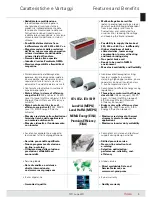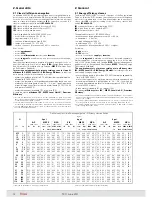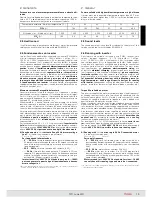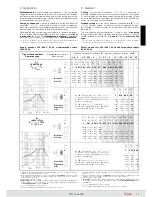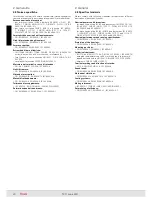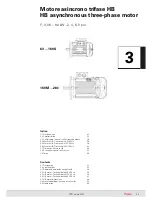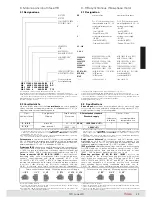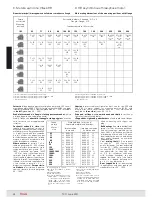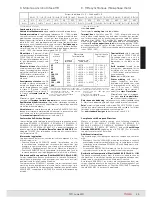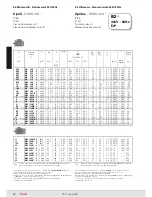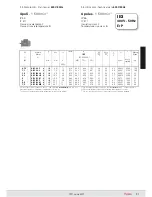
16
TX11 June 2011
B) Funzionamento a
U
/
f
≈
costante fino a 87 Hz
(
motore collega-
to a
); consente di aumentare la potenza motore, di funzionare a
frequenze più elevate a pari rapporto di variazione o di aumentare
il rapporto di variazione a pari declassamento
C
, ecc.):
P
a n max
≈
1,73
P
N
,
I
≈
1,73
I
N 400 V
≈
I
N 230 V
Per frequenza di alimentazione
:
–
5
1)
35,5 Hz
, il motore autoventilato è poco raffreddato quindi
M diminuisce al diminuire della velocità (
M
rimane costante nel
caso di motore servoventilato o per servizio intermittente; ved.
linea tratteggiata);
–
35,5
87 Hz
, il motore funziona a
M
costante (
≈
M
N
);
–
87 Hz
, il motore funziona a potenza
P
costante (
≈
1,73
P
N
) con rapporto
U
/
f
progressivamente ridotto (la frequenza
au menta mentre la tensione rimane costante) e conseguente
calo proporzionale di
M
a pari corrente assorbita.
1) Nel caso di alimentazione motore con inverter vettoriale, il momento torcente
M
per
servizio continuo rimane costante fino a circa 2,5 Hz.
L’entità del
declassamento C
=
M
/
M
N
cui deve essere sottoposto
il momento torcente nominale per ottenere il momento torcente
erogabile dal motore è normalmente deducibile dal diagramma
seguente (ved. anche nota 5).
Il momento torcente massimo
dipende dalle caratteristiche dell’in-
verter e dalla
corrente di limitazione da esso imposta
. Normal-
mente non si superano i valori deducibili dal diagramma. Con inverter
vettoriale si ha una riduzione più contenuta alle basse frequenze (es.:
M
max
/
M
N
≈
1,5
1,3 per
f
= 5
2,5 Hz).
B) Running with
U/f
≈
constant up to 87 Hz
(
-connected motor
);
it allows to increase the motor power, to run at higher frequency
with the same frequency variation ratio or to increase the fre-
quency variation ratio at the same derating coefficient
C
, etc.):
P
at n max
≈
1,73
P
N
,
I
≈
1,73
I
N 400 V
≈
I
N 230 V
For supply frequency
:
–
5
1)
35,5 Hz
, since self-cooled motor is slightly cooled,
M
is
decreased by decreasing speed (
M
keeps constant for indepen-
dently cooled motor or for intermittent duty; see short dashed
line);
–
35,5
87 Hz
, motor runs at constant
M
(
≈
M
N
);
–
87 Hz
, motor runs at constant
P
(
≈
1,73
P
N
) with progres-
sively decreased
U
/
f
ratio (frequency increases while voltage
keeps unchanged) and following proportional decrease of
M
at
the same current absorbed.
1) In case of motor supply using vector inverter, for continuous duty torque
M
keeps
constant down to about 2,5 Hz.
The derating
coefficient C
=
M
/
M
N
to be applied to nominal torque
in order to achieve the torque provided by motor is given by the fol-
lowing diagram (see also note 5).
The max torque
depends on the inverter features and on the max
limitation current setting
. Usually, the values deducible from the
diagram are not exceeded. With vector inverter, the torque reduction
is slighter at low frequencies (e.g.:
M
max
/
M
N
≈
1,5
1,3 for
f
=
5
2,5 Hz).
1) Curva valida per motore servoventilato o per servizio intermittente.
2) Curva valida per
M massimo per brevi periodi (accelerazioni, decelerazioni, sovraccarichi
di breve durata).
3) Velocità reale approssimativa che tiene conto sia dello
scorrimento
a momento nomi-
nale, sia del «boost» di tensione alle basse frequenze (con controllo vettoriale lo
scorri-
mento
può essere leggermente inferiore).
4) Collegamento a
e funzionamento a
U/f
≈
costante fino a 87 Hz.
5)
IMPORTANTE
: curva valida per motori grand.
160M, motori contrassegnati nel
programma di fabbricazione dal simbolo
, o in caso di inverter con forma d’onda
«scadente».
1) Curve valid for independently cooled motor or for intermittent duty.
2) Curve valid for max
M for short times (accelerations, decelerations, short time overlo-
ads).
3) Approximate real speed refers both to slipping at nominal torque and to voltage «boost»
at low frequency (with vector control,
slip
can be slightly lower).
4)
-connection and running with
U/f
≈
constant up to 87 Hz.
5)
IMPORTANT
: curve valid for motor size
160M, motors signed in the selection tables
by symbol
or in case of inverter with low quality wave shape.
Scelta del motore
Polarità
. Il motore a
2 poli
è consigliabile quando siano richieste
velocità elevate in quanto è meno adatto a trasmettere il momento
torcente con regolarità a bassa frequenza di alimentazione ma con-
sente di ottenere potenze più elevate a pari grandezza; al contrario
il motore a
6 poli
è consigliabile quando siano richieste velocità
continuative molto basse.
Normalmente il 4 poli rappresenta il
migliore compromesso
.
Motor selection
Polarity
.
2-poles
motor is advisable when high speeds are reque-
sted since it is less suitable to transmit the torque in a regular way
at low supply frequency, but it allows to achieve higher powers at
the same size; on the contrary
6-poles
motor is advisable when
very low continuous speeds are requested.
Usually, 4-poles motor
represents the best compromise
.
2. Generalità
2. General
Summary of Contents for TX11 Series
Page 2: ......
Page 203: ...203 TX11 June 2011...




